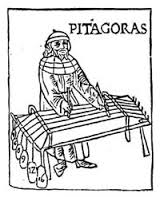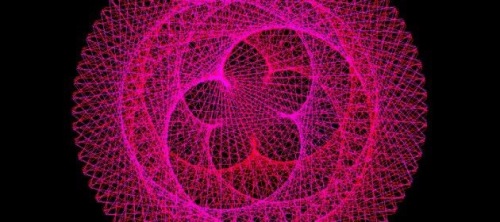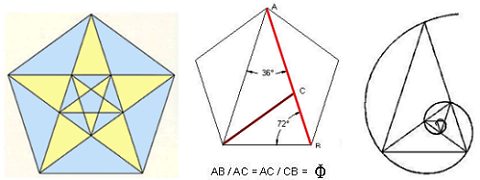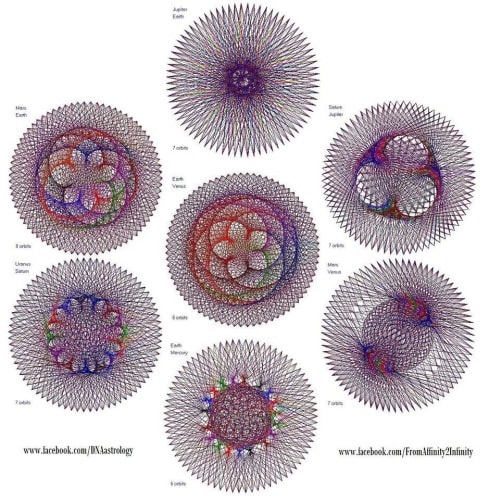“In truth, We appreciate above all constructions founded on the higher principles of harmony… The creative power of beauty depends on this principle, and the strength of harmony is affirmed by it. Great structures are erected only in unity.”
WHOLE NUMBERS*
As seems clear from the preceding considerations, the numerical and arithmetical aspect of the series of higher and lower harmonics consists of the series of whole numbers and their reciprocal numbers. This fact is natural and simple only in appearance. If one limits oneself to accepting it as such, one loses the opportunity of being amazed by one of the most wonderful continuities of the physical world. Whole numbers have been given much attention by the best mathematicians and philosophers for a long time and all agree in considering that the concept of whole number is anything but simple. In this regard, one can introduce this reasoning, of a typically Pythagorean nature: let any group of objects be considered. It is inevitable that they have a number. That is, that group will necessarily be composed of 3,15 or 200 objects. Could that group exist without this number? Certainly not. No number, no group, no objects. So the whole number is an essential constituent of anything. Nothing appears, nothing is perceived without the participation of a whole number. This way of thinking, which is perfectly rational, illustrates quite well the profound nature of the concept of number, which normally escapes superficial and conventional observation. Number is a power, a quality, an indispensable element of manifestation. Any inner energy must express itself with the participation of number.
If one now places beside this superior conception of number the idea of sound as a creative element, one understands much better the amazing, orderly concurrence of both in the series of higher harmonics, generated spontaneously by the fundamental sound.
 It is in the sense set out in these pages that the concept of number must be understood, in the harmonical and Pythagorean sense. Number is not only quantity. Its roots lie in the very necessity of creation. It is true that groups or collections of things can be imagined also without knowing their number: for example, who knows how many grains of sand there are on a beach? But the not-knowing of the number does not imply that it does not exist as an indispensable contributor to the perceptible appearance of the object. The number is not everything. Here it is affirmed, however, that it is an essential part of the process of creation. With this one comes quite close to understanding the statement of the Pythagoreans, according to whom “everything has a number, and a number is in everything”.
It is in the sense set out in these pages that the concept of number must be understood, in the harmonical and Pythagorean sense. Number is not only quantity. Its roots lie in the very necessity of creation. It is true that groups or collections of things can be imagined also without knowing their number: for example, who knows how many grains of sand there are on a beach? But the not-knowing of the number does not imply that it does not exist as an indispensable contributor to the perceptible appearance of the object. The number is not everything. Here it is affirmed, however, that it is an essential part of the process of creation. With this one comes quite close to understanding the statement of the Pythagoreans, according to whom “everything has a number, and a number is in everything”.
The number, which is a recognized expression of the quantitative and therefore inferior aspect of manifestation, performs, in the light of the preceding considerations, a role of mysterious, divine efficacy.
It is evident that any group of objects in which, for example, the quality of the number 5 operates is in contact, or in resonance, with all the other infinite manifestations of the same number. This opens up the way to a really sublime mathematics, which for the present remains completely unknown. One can add again, in this regard, that only the Infinite is able to liberate that which the number confines. Number and Infinite are thus placed as opposite, yet assisting, principles: the number extracts the treasures from the Infinite and presents them; the Infinite liberates the condensed energies from the number and puts them back in their primeval state, without limits or form.
“A cosmic concordance is established only where the Fire of Space enters into resonance with the subtle harmonies.”
THE QUANTA
One of the aspects of the law of the higher harmonics is its peculiar progress: the original sound, in vibrating, generates other innumerable sounds “ad infinitum”, but in an intermittent, discontinuous way. The whole of the sounds thus produced is not continuous, but arranged by degrees; it is a granulation rather than a current.
Between one and the other of the successive sounds, gaps open up, as it were, spaces (intervals) which are never eliminated, however far one goes ahead in the development. This way of describing the phenomenon is improper, but certainly illustrates this characteristic quality. The original phenomenon, which is an oscillation, is of a continuous nature, yet it produces a discontinuity. Only if one supposes that the primary sound vibrates infinitely can one think that the whole generated by it, composed of the infinite wholes produced by each of the innumerable harmonics, saturates the whole of space, or rather produces the infinite and continuous whole of all the possible sounds. This property recalls the great debate, never resolved by the various philosophical schools, about the real consistency of the primordial substance: is is a “continuum” or a “discretum”? In short, is that thing which is the basis of everything something granular or is it without fissures?
Many phenomena incline one to believe in one of the solutions, and just as many in the other. Suffice it to cite the paradoxical case of light, which in certain phenomena behaves as if it has an ondulatory (continuous) nature and in others as if it were granular (discontinuous), so that it confounds physicists and philosophers and arouses irremediable controversies.
Max Planck, at the beginning of the century, while studying the absorption of energy of a black body, was the first to notice its strange behaviour: it absorbed luminous energy in a continuous way and returned it at intervals, in the form of heat. Such discontinuous emissions of energy, constant in themselves, were called “quanta”, and since then physics has been enriched by a new field of knowledge and experience. Between the opposing factions, favouring the “continuum” or the “discretum”, an armistice was imposed, very similar to a peace, but still disturbed by this basic perplexity: how can one and the same thing simultaneously demonstrate exactly contrary qualities?
The law of the higher harmonics is a clear example of this extraordinary procedure of nature, which seems superior and transcendent, and shows that ultimate reality must be sought in a world without dualism. Sound, understood as value, is continuous, as it is a phenomenon of oscillation and has an ondulatory nature. As number, on the other hand, it is a “discretum”. Its nature is, therefore, also in this way ambivalent; and the higher harmonics confirm this.
***
The foregoing suggests a question: given that both the opposites have a real basis, does a recognized principle exist which is common to both and reconciles them in itself?
Certainly there is, and this principle is Truth itself. But it remains elusive and unknowable to the intellect, which is by nature analytical and dualistic. One cannot hope to know such a truth by using a means (reasoning) which is by nature unsuitable to perceiving it.
Certainly that principle exists, and it is the Cause of both manifestations. Reason leads us, honestly, to its limits and shows them to us. It cannot cross them. Another Guide is needed to explore what it beyond those gates. But this is the subject of another science.
As an answer – imperfect – to the question thus posed one can perhaps point out that one property is common both to the “continuun” and to the “discretum”: rhythmic order. For a careful observer, both one and the other obey the law of rhythm, which regulates both the continuous and the granular. An oscillation arranges in a regular form both water and grains of sand; and the great law of the higher harmonics itself governs the appearance of the successive granules of sound with marvellous, orderly precision.
***








